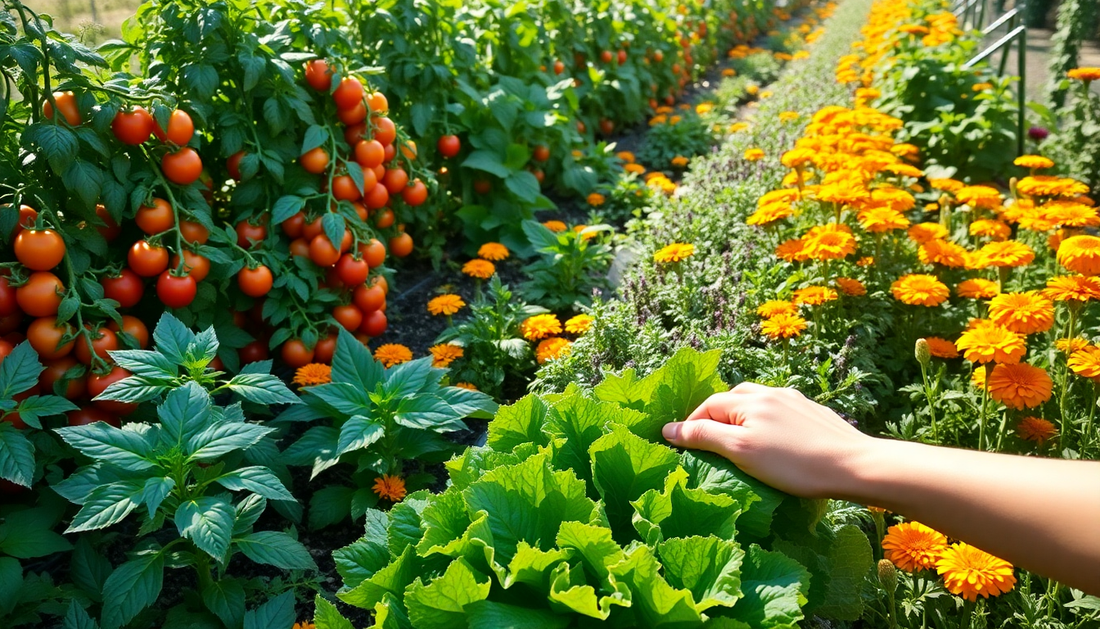
Unlocking the Secrets of Companion Planting: A Guide to Thriving Vegetable Gardens
Share
In the ever-evolving world of sustainable gardening, one technique has gained significant traction: companion planting. This age-old practice of strategically pairing different plants in a vegetable garden has the power to transform your growing space into a thriving, harmonious ecosystem. Whether you're a seasoned green thumb or a budding gardener, mastering the art of companion planting can unlock a world of benefits for your vegetable garden.
The Principles of Companion Planting
Companion planting is rooted in the understanding that certain plants can work together to enhance each other's growth, deter pests, and create a more balanced, resilient garden. By carefully selecting and arranging your vegetable crops, you can harness the natural synergies between plants, leading to a more productive and eco-friendly growing environment.
Nutrient Sharing and Soil Enrichment
One of the fundamental principles of companion planting is the concept of nutrient sharing. Some plants are adept at drawing specific nutrients from the soil, while others may be better at replenishing those same nutrients. By pairing these complementary plants, you can create a symbiotic relationship that benefits the entire garden.
For example, legumes like beans and peas are known for their ability to fix nitrogen in the soil, making it available for other plants. By planting them alongside heavy nitrogen-feeders like tomatoes or leafy greens, you can ensure a steady supply of this essential nutrient. Similarly, deep-rooted plants like carrots can help loosen compacted soil, allowing shallower-rooted crops to thrive.
Pest and Disease Management
Companion planting also plays a crucial role in managing pests and diseases in the vegetable garden. Certain plants possess natural compounds or physical characteristics that can deter or confuse common garden pests. By strategically placing these "trap crops" or "repellent plants" around your main crops, you can create a natural barrier against unwanted visitors.
Marigolds, for instance, are known for their ability to repel nematodes, while the strong scent of herbs like basil, rosemary, or thyme can confuse and deter aphids, spider mites, and other sap-sucking insects. Interplanting these aromatic plants throughout your garden can help maintain a healthy, pest-free environment.
Pollinator Attraction and Biodiversity
In addition to pest management, companion planting can also enhance the overall biodiversity of your vegetable garden. By incorporating a diverse array of plants, you can attract a wide range of beneficial insects, pollinators, and other wildlife that contribute to a thriving ecosystem.
Flowering plants like sunflowers, cosmos, and borage not only add visual interest to your garden but also provide nectar and pollen sources for bees, butterflies, and other pollinators. These pollinators, in turn, play a crucial role in the reproduction and productivity of your vegetable crops.
Companion Planting Strategies for Thriving Vegetable Gardens
Now that you understand the principles behind companion planting, let's explore some practical strategies to implement in your own vegetable garden.
Vertical Gardening and Trellising
One effective companion planting technique is the use of vertical gardening and trellising. By pairing climbing or vining crops, such as pole beans, cucumbers, or tomatoes, with sturdy support structures, you can maximize your growing space and create a more organized, efficient garden layout.
Companion plants that work well with vertically grown crops include low-growing herbs, leafy greens, or shallow-rooted vegetables that can thrive in the spaces between the taller plants. This arrangement not only saves valuable ground space but also improves air circulation, reducing the risk of disease and pests.
Intercropping and Succession Planting
Intercropping, the practice of growing two or more crops simultaneously in the same growing area, is another powerful companion planting strategy. By carefully selecting crops with different maturity rates and growth habits, you can ensure a continuous harvest throughout the season.
For example, you might plant fast-growing radishes or lettuce between rows of slower-maturing crops like carrots or beets. As the radishes and lettuce are harvested, the carrots and beets will have ample room to develop. This approach not only maximizes your garden's productivity but also helps suppress weed growth and maintain soil moisture.
Succession planting, where you sow new crops in the spaces left by harvested plants, can also be integrated into your companion planting system. By carefully planning your garden layout and crop rotation, you can ensure a steady supply of fresh produce while maintaining the overall health and balance of your vegetable garden.
Polyculture Planting
Polyculture, the cultivation of multiple crop species in the same growing area, is a holistic approach to companion planting that mimics the diversity found in natural ecosystems. By combining a variety of vegetables, herbs, flowers, and even edible perennials, you can create a self-sustaining, low-maintenance garden that is resilient to pests, diseases, and environmental stresses.
In a polyculture system, each plant plays a specific role, whether it's providing shade, attracting beneficial insects, or repelling common garden pests. By carefully arranging these complementary plants, you can create a harmonious and productive growing environment that requires minimal intervention.
Putting It All Together: Companion Planting in Action
Now that you've explored the principles and strategies of companion planting, it's time to put them into practice in your own vegetable garden. Remember, the key to success lies in observing your garden's unique conditions, experimenting with different plant combinations, and being open to the lessons that your growing space has to teach you.
Start by identifying the specific challenges or goals you have for your garden, whether it's improving soil fertility, managing pests, or enhancing biodiversity. Then, research the companion planting relationships that can address those needs. Don't be afraid to try new things and learn from your successes and failures – that's all part of the joy of gardening!
By embracing the principles of companion planting, you'll not only cultivate a thriving, productive vegetable garden but also contribute to the overall health and resilience of your local ecosystem. So, get out there, get your hands dirty, and let the magic of companion planting transform your growing space into a true oasis of abundance.
